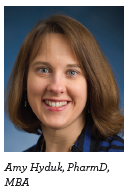Publication
Article
Pharmacy Careers
The Path Less Traveled: The Nonclinical Pharmacist
Author(s):
Nonclinical pharmacists can still have a meaningful impact on patient care.
Nonclinical pharmacists can still have a meaningful impact on patient care.
As pharmacists, we are in the business of taking care of patients. That’s why we are all required to complete patient care rotations before becoming licensed pharmacists.
Patient care is at the very essence of what pharmacists do. The word “clinical” means of or relating to the observation and treatment of actual patients.
However, I argue that there’s a new, less explored pathway that is available to the new pharmacist: that of the nonclinical pharmacist. By nonclinical, I mean that the new pharmacist in some cases may not have direct contact with individual patients one-on-one; instead, she works in an area of pharmacy or health care that has indirect impact on hundreds or thousands of patients. She’s still using her clinical knowledge but at a broader or wider level.
The nonclinical pharmacist could work in administration, technology, managed care, formulary management, entrepreneurship, drug information, pharmaceutical or biotech, big data, or management—just to name a few areas. I would also argue in many cases that the nonclinical pharmacist is more likely to be a leader within an organization.
For the purposes of this article, I wanted to take a look at 2 nonclinical pharmacists to explore how they each found the path less traveled, and more importantly, what advice they had for the rest of us in pharmacy, particularly for those of us that have interests beyond clinical pharmacy.
The Clinical to Administrative Career Path

Our first pharmacist is Amy Hyduk, PharmD, MBA, a network pharmacy director at Lutheran Health Network. Although she originally worked in direct patient care, she now oversees network standardization, integration, and growth of hospital pharmacy services between 8 hospitals in Fort Wayne, Indiana, and the surrounding area. At the main hospital, Lutheran Hospital, she also serves as the pharmacy director overseeing full operations of the pharmacy department and services.
“I had always had an interest in pediatrics and planned on focusing in that area,” Dr. Hyduk said. “Upon graduation, I took a job as a clinical pharmacist at Lutheran Hospital, where I focused on the development of some pediatric pharmacy services, including a new pediatric ketogenic diet clinic for children with seizure disorders that were not well-controlled with medication therapy.”
Dr. Hyduk always had a passion for clinical pharmacy. However, over time, she grew interested in leadership roles.
“After I had been at Lutheran Hospital for almost a year, an opportunity developed with a new MBA program that allowed for the specialization in targeted areas such as health care administration,” she explained. “During that program, I was then promoted to a network clinical manager position. Between the job responsibilities of my new position and the experiences from the MBA program and a yearlong leadership program that I had completed within my health system, my interest in a pharmacy administrative level position grew significantly. I learned that my strengths and passion were stronger in developing and organizing programs and policies, reviewing processes, and identifying areas for process improvement and analysis of quality and clinical data.”
Several Paths Lead to Health Care Entrepreneurship

Our second nonclinical pharmacist is Shaun Young, PharmD, MBA, CEO of Ardina. Dr. Young also worked in a variety of pharmacy and health care settings, including but not limited to: community practice pharmacy, pharmaceutical industry in sales, an outpatient pharmacy supervisor, a director of health care innovation for a large retailer, and vice president of a consumer health division of one of the largest pharmacy wholesalers in the country, all prior to his current role of CEO and founder of Ardina.
“I’ve touched pretty much every part of the pharmacy value chain, but right out of pharmacy school I was debating whether or not to go to medical school,” Dr. Young said. “I got into medical school and a week before med school orientation, I decided against it, and headed to a retail pharmacy chain instead. I was a graveyard pharmacist, then became a pharmacy manager. My career ADD [attention deficit disorder] kicked in, so then I took a job in pharmaceutical sales with Eli Lilly and worked in a variety of other pharmacy areas, before business school.”
Once he graduated from business school, Dr. Young led health care innovation at a large retailer. There, he was able to help make health care more affordable and accessible for patients.
“After that, Cardinal Health recruited me, and as of a year ago, I started my own business called Ardina to help make health care benefits more affordable and accessible, particularly to the millennial generation and small businesses,” Dr. Young said.
Advice for the New Path
When asked about the nonclinical career pathway, both of these pharmacists stated that it is important to keep an open mind.
“I had my 10-year plan all mapped out, but fortunately I took advantage of several opportunities that presented themselves to me and followed what felt right for that point in time,” Dr. Hyduk said. “It led to a total change in my career goals and plans, but I wouldn’t change it or the experiences I’ve had along the way.”
“Don’t let what you see in pharmacy be the limits for your career,” Dr. Young said. “If you have an interest in administration, don’t limit yourself by only what you see. Be open. Consider non-pharmacy jobs. Be curious.”
I asked Dr. Young if he had a career plan during or right after pharmacy school, to which he replied with a Mike Tyson quote: “I had a plan until I got punched in the face.”
“My plan at first was medical school, which I deviated from,” he explained. “Then I went to retail pharmacy, and my plan was to be a district manager, but again [there was] another deviation. When I went into pharmaceutical sales, my plan was to move into the medical science liaison role—again, another deviation. Every career divergence happened because of someone I met.”
Dr. Hyduk also mentioned networking as pivotal to her career.
“If you have an interest in a nonclinical position, particularly because they seem to be currently fewer and less advertised than the clinical positions, find other pharmacists in those positions that you can begin building a professional relationship with,” she said. “Identify opportunities to shadow, intern, or do a rotation in the nonclinical area of interest. Join professional organizations where you can network with others with similar career interests. While it’s important to meet and network with pharmacists in your area of focus, don’t limit your networking to just those individuals in that particular area.”
Dr. Hyduk said she was able to experience some great opportunities because of networking with individuals both inside and even outside the pharmacy world.
“You never know where networking opportunities with clinical pharmacists, with other health care professionals and also with non-health care professionals can lead,” she said.
While there is no doubt that pharmacy will always touch the lives of individual patients, the good news is that both now and well into the future, the role of non-direct-patient-care pharmacists can also make huge, even dramatic impacts on health care and pharmacy.
Whatever path you choose, know that there’s usually many paths that can lead you to a fantastic, one-of-a-kind career built just for you.
Erin L. Albert is a pharmacist, entrepreneur, author, lawyer, associate professor at Butler University College of Pharmacy and Health Sciences, and health outcomes pharmacist with Myers and Stauffer LC. To learn more about her nontraditional career path, check out her website at erinalbert.com.







